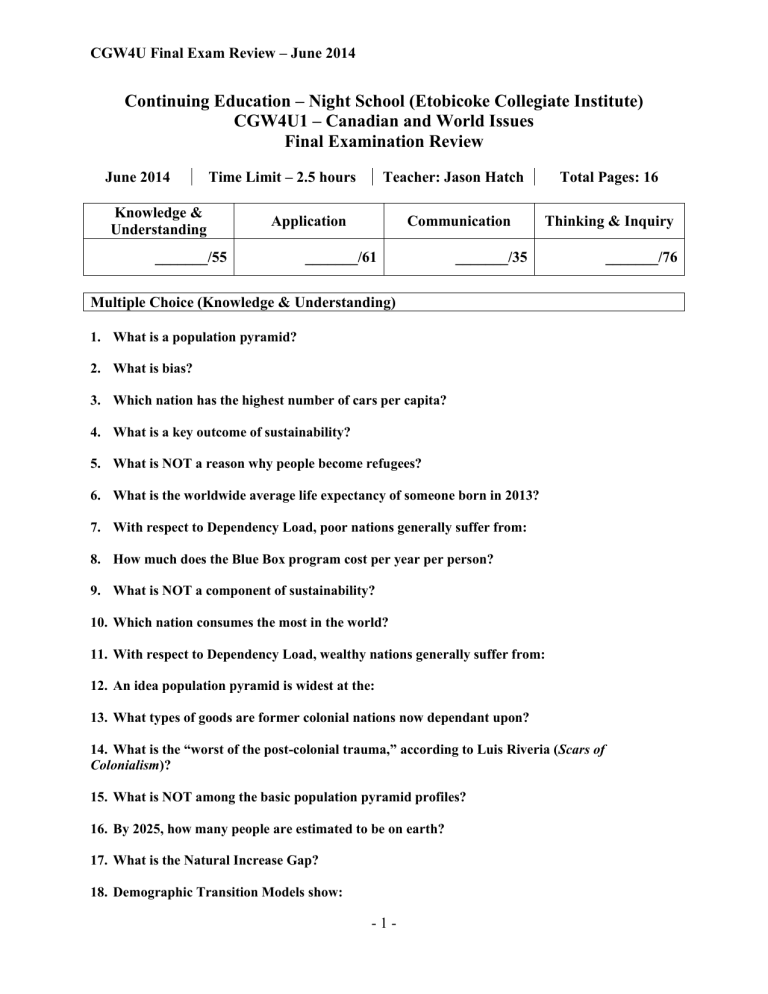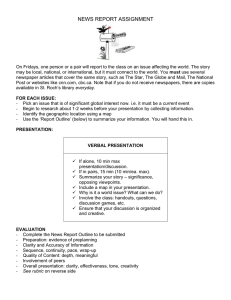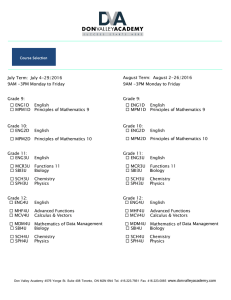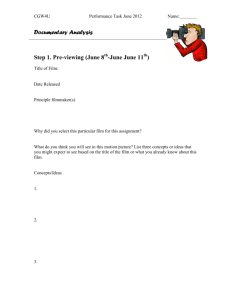final exam june 2014 review
advertisement

CGW4U Final Exam Review – June 2014 Continuing Education – Night School (Etobicoke Collegiate Institute) CGW4U1 – Canadian and World Issues Final Examination Review June 2014 Time Limit – 2.5 hours Knowledge & Understanding Teacher: Jason Hatch Application _______/55 Communication _______/61 Total Pages: 16 Thinking & Inquiry _______/35 Multiple Choice (Knowledge & Understanding) 1. What is a population pyramid? 2. What is bias? 3. Which nation has the highest number of cars per capita? 4. What is a key outcome of sustainability? 5. What is NOT a reason why people become refugees? 6. What is the worldwide average life expectancy of someone born in 2013? 7. With respect to Dependency Load, poor nations generally suffer from: 8. How much does the Blue Box program cost per year per person? 9. What is NOT a component of sustainability? 10. Which nation consumes the most in the world? 11. With respect to Dependency Load, wealthy nations generally suffer from: 12. An idea population pyramid is widest at the: 13. What types of goods are former colonial nations now dependant upon? 14. What is the “worst of the post-colonial trauma,” according to Luis Riveria (Scars of Colonialism)? 15. What is NOT among the basic population pyramid profiles? 16. By 2025, how many people are estimated to be on earth? 17. What is the Natural Increase Gap? 18. Demographic Transition Models show: -1- _______/76 CGW4U Final Exam Review – June 2014 19. What is the currency of the European Union? 20. What is Zionism? 21. What nation is NOT a former colonial possession? 22. Which nation held the most colonial possessions? 23. What is an example of a political enclave? 24. Which of the following was NOT a colonial power? 25. What is NOT an example of an international alliance? 26. What is counterterrorism? 27. What nation is traditionally the home of the most immigrants to Canada? 28. What is a cause of the increased immigration to Canada since the 1980s? 29. What is migration? 30. What has neo-nationalism come to represent? 31. What is a political enclave? 32. What is NOT a group associated with Quebec sovereignty? 33. What is “geopolitics”? 34. Approximately how many people were killed in Rwanda in the early 1990s? 35. What is colonialism? 36. According to Therese Delpech (The Imbalance of Terror), which nation is NOT among the three power nations in the post-Cold War period? 37. Where does most coffee production take place? 38. What is usually a problem associated with post-colonialism? 39. What was NOT among the three things “invented” by the West, according to Dinesh D’Souza (Three Cheers for Colonialism)? 40. What is the greatest thing the British colonialism provided, according to D’Souza? 41. What was the purpose of colonies? 42. What was a significant cause of the deaths in Rwanda in the early 1990s? -2- CGW4U Final Exam Review – June 2014 43. What was a significant issue faced by Palestinians with the creation of Israel? 44. What is a residual effect of colonialism in former colonial nations? 45. What is a problem with the way food population and human population grow? 46. When did the Canadian government begin to get more involved in the direction of the economy? 47. Sand covers what percentage of the world’s deserts? 48. What did Adam Smith say was the best way to ensure prosperity? 49. What percent of US adults drink coffee each day? 50. What is the Sahel? 51. The surface level of Lake Mead has dropped ____m between 2000 and 2005 52. Governments who get actively involved in an economy is known as a: 53. What is nationalism? 54. When was the EU founded? 55. What is the world’s largest polluter? 56. What type of government management style has taken off since the 1980s? 57. What is a key focus of neo-liberal governments? 58. Since 1960, the life expectancy in development countries has risen by: 59. What do Fair Trade markets do? 60. Sum of Ranks is used to: 61. How many major types of biomes are there in the world? 62. What type of economy do we have in Canada? 63. The extra cost for Fair Trade is called: 64. What is the single best indicator of national prosperity? 65. What is the most water-rich nation in the world? 66. What percentage of the world’s population are water stressed? 67. What is the world’s second most valuable traded commodity? 68. What are trans- or multi-national companies? -3- CGW4U Final Exam Review – June 2014 69. What world city is growing the fastest: 70. Global warming is caused, partially, by: 71. Which nation has the highest consumption growth rate? 72. What is the primary energy source of the world? 73. What is the Dependency Load? 74. What is an ideal situation for a nation, population-wise? 75. What is the “ecological view”? 76. Early immigration to Canada was dominated by: 77. What is the largest city in the world? 78. What is sovereignty? 79. What is NOT generally considered to be a cause of terrorism? 80. How many refugees does Canada accept per year? 81. When was the concept of sustainability introduced? 82. Which nation has the lowest consumption growth rate? 83. What is the Kyoto Protocol? 84. What is the major recycling initiative in Ontario? 85. Which nation consumes the most energy per capita? 86. What is an ecological footprint? 87. How many trees do we cut down per week? 88. _________ are vehicles powered by gasoline and electricity: 89. The UN estimates that there are ___ refugees worldwide: 90. About how much total food is available per person per day? 91. The UN says that a person needs ___ of water per day: 92. What is NOT an example of Canada’s progressive government actions? 93. What percent of the world is urbanized today? -4- CGW4U Final Exam Review – June 2014 94. Which resource is consumed as much or more in poor nations than in rich nations? 95. What is NOT a traditional energy source? 96. What is the “expansionist view”? 97. The gap between rich and poor has grown ___ as quickly in Vancouver as it has in the rest of Canada: 98. What is globalization? 99. Where does Canada generally rank in resource consumption in the world? 100. Sustainable cities do NOT have: Population Pyramid (Thinking & Inquiry and Application) Using the information provided below, create a Population Pyramid for the United States (2013) on the graph paper on the next page. Do not worry about colouring or shading the Pyramid. Age All ages .Under 5 years .5 to 9 years .10 to 14 years .15 to 19 years .20 to 24 years .25 to 29 years .30 to 34 years .35 to 39 years .40 to 44 years .45 to 49 years .50 to 54 years .55 to 59 years .60 to 64 years .65 to 69 years .70 to 74 years .75 to 79 years .80 to 84 years .85 years and over Both sexes Number Percent 308,827 20,110 20,416 20,605 21,239 21,878 20,893 20,326 19,140 20,787 21,583 22,372 20,470 17,501 13,599 9,784 7,331 5,786 5,006 100.0 6.5 6.6 6.7 6.9 7.1 6.8 6.6 6.2 6.7 7.0 7.2 6.6 5.7 4.4 3.2 2.4 1.9 1.6 Male Number 151,175 10,273 10,427 10,529 10,840 10,987 10,430 10,034 9,421 10,255 10,584 10,906 9,879 8,278 6,461 4,519 3,122 2,421 1,809 Percent 100.0 6.8 6.9 7.0 7.2 7.3 6.9 6.6 6.2 6.8 7.0 7.2 6.5 5.5 4.3 3.0 2.1 1.6 1.2 Female Number Percent 157,653 9,837 9,989 10,076 10,399 10,891 10,464 10,292 9,719 10,532 11,000 11,466 10,592 9,223 7,139 5,265 4,209 3,365 3,196 100.0 6.2 6.3 6.4 6.6 6.9 6.6 6.5 6.2 6.7 7.0 7.3 6.7 5.8 4.5 3.3 2.7 2.1 2.0 Data from http://www.census.gov/population/age/data/2012comp.html -5- CGW4U Final Exam Review – June 2014 -6- CGW4U Final Exam Review – June 2014 Population Pyramid Identification (Application) 1. Name: __________________________ 2. Type of Growth: ______________________ Name: __________________________ 3. Type of Growth: ______________________ Name: __________________________ Type of Growth: ______________________ -7- CGW4U Final Exam Review – June 2014 Immigration Chart (Thinking & Inquiry) One hundred years of immigration to Canada (1901-2001) Date Top countries of origin of immigrants to Canada Significant Event 1900 to 1910 1911 to 1920 1921 to 1930 1931 to 1940 1941 to 1950 1951 to 1960 1961 to 1970 1971 to 1980 1981 to 1990 1991 to 2000 -8- CGW4U Final Exam Review – June 2014 World Urban Population I (Application) Using the graph area provided, create a line graph showing the level of urbanization in the world during the Twentieth Century. Year 1950 1955 1960 % 29.8 31.7 33.7 1965 35.5 1980 39.6 1970 36.8 1985 41.5 1975 38.0 1990 43.5 1995 45.3 2000 47.3 2005 49.3 -9- 2010 51.5 2015 53.7 2020 55.9 2025 2030 58.1 60.2 CGW4U Final Exam Review – June 2014 World Urban Population II (Thinking & Inquiry and Communication) After completing the previous graph and using the data, answer the following questions. Myths of the Refugee (Thinking & Inquiry) Graph Analysis (Thinking & Inquiry and Application) Examine the two graphs below and then answer the question that follows the graph. Your task is to provide clear and insightful analysis on the graphs provided. Banana Split (Thinking & Inquiry) - 10 - CGW4U Final Exam Review – June 2014 Government Programs (Application) Look at the Program Bank and then write if it is a FEDERAL, PROVINCIAL, or MUNICIPAL program on the line beside the program. Program Canadian Ice Service Landfills Regional Cycling Plan Study Fire Hydrants Clean Water Regulations Water Testing Partners in Flights Environmental Effects Monitoring Environmental Standards Watershed Management Sewage Treatment Plants Oil, Gas and Energy Branch Green Industrial Analysis and Retrofits Leaf and Yard Waste Pickup Science Horizons Level of Government Sum of the Ranks (Application) Country Statistic A: Rank Statistic B: - 11 - Rank Statistic C: Rank Sum of Ranks CGW4U Final Exam Review – June 2014 City Millionaires (Thinking & Inquiry) Complete the chart below with the number of “millionaire cities.” 1950 1973 2004 2015 North America Asia Europe Africa South America North American Biomes (Application) On the map below, place the biome (a list of North American biomes is included) over the appropriate area. You will want to make sure that you include a legend on the map to indicate which shading represents which biome. Tundra Grasslands Taiga Deciduous Forest Desert Chapparel Rainforests - 12 - CGW4U Final Exam Review – June 2014 CO2 Emissions (Application) - 13 - CGW4U Final Exam Review – June 2014 Right to Asylum (Thinking & Inquiry and Application) Read the case study below. Using the UN documents provided, decide whether or not this person would be accepted as a refugee or if they will be sent back to their country. UN Documents 1951 Convention and Protocol Relating to the Status of Refugees Article 1: Definition of the term refugee A. (2) ...owing to well-founded fear of being persecuted for reasons of race, religion, nationality, membership of a particular social group or political opinion, is outside the country of his nationality and is unable or, owing to such fear, is unwilling to avail himself of the protection of that country; or who, not having a nationality and being outside the country of his former habitual residence as a result of such events, is unable or, owing to such fear, is unwilling to return. F. The provisions of this Convention shall not apply to a person with respect to whom there are serious reasons for considering that: (a) he has committed a crime against peace, a war crime, or a crime against humanity, as defined in the international instruments drawn up to make provision in respect of such crimes (b) he has committed a serious non-political crime outside the country of refuge prior to his admission to that country as a refugee (c) he has been guilty of acts contrary to the purposes and principles of the United Nations. Universal Declaration of Human Rights Article 14 1. Everyone has the right to seek and to enjoy in other countries asylum from persecution. 2. This right may not be invoked in the case of prosecutions genuinely arising from non-political crimes or from acts contrary to the purposes and principles of the United Nations. Short Response (Thinking & Inquiry/Application and Communication) 1. Thinking back to the Global Classification Systems worksheet, discuss how the world has changed since 1907. Use specific examples and details from the worksheet to support your answers. [Classifications] 2. Discuss how politics and geography are related. [Geopolitics] 3. What are some of the positive and negative aspects of colonialism? Upon which side do you fall? [Colonialism] 4. What are some of the criticisms of Rachel Carson’s Silent Spring? [Criticisms] 5. What are some of the sustainable initiatives taken by Wolfville, Nova Scotia and Vancouver? [Initiatives] 6. How are the national-sovereigntist-devolutionist movements in Great Britain and Canada alike? Compare and contrast the two movements and discuss the validity of some of each movement’s claims. [Movements] 7. Is the HDI a good or bad way to measure the quality of life of people around the world? Use specific examples and details from the worksheet to support your answers. [HDI] 8. Explain the strengths, weaknesses, similarities and differences between the population theories of Thomas Robert Malthus and Adaption Theory. [Population] - 14 - CGW4U Final Exam Review – June 2014 Alliances (Application) AU ASEAN NATO - 15 - APEC OAS


